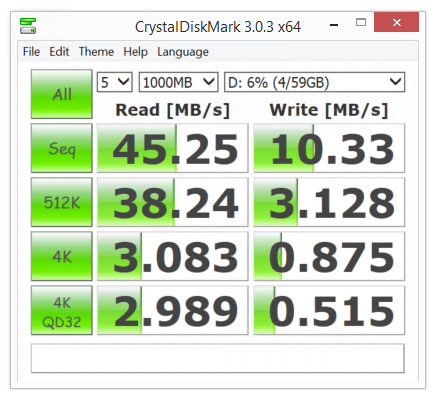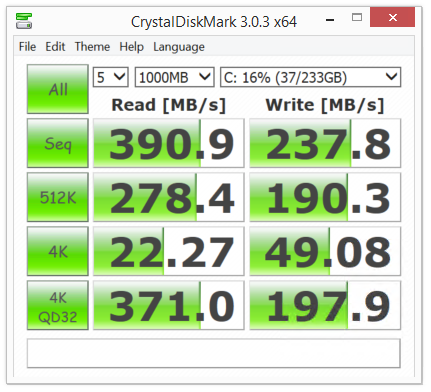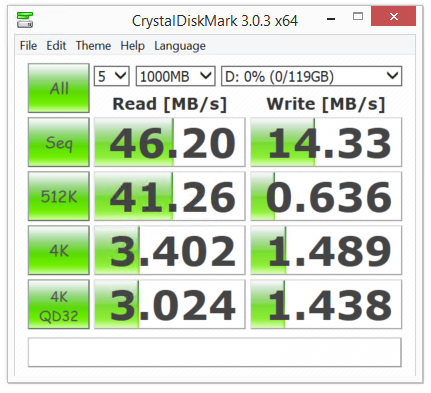Now that I’m the proud owner of a Microsoft Surface Pro 3 (SP3), I’ve taken the plunge to buy into the largest microSDXC component currently available. These days, that’s a whopping 128 GB, which is an amazing amount of storage to cram into a device that’s about the same size as my pinky nail. I plunked down about $120 at Newegg for a SanDisk Ultra model that’s rated as a UHS-1/Class 10 device, which is supposed to make it the fastest device of its type around. Given that the device I’m currently using in the SP3 is rated the same — it’s “only” 64 GB in size, however, from the same maker — I’m not expecting blazing fast performance by any stretch of the imagination. This CrystalDiskMark output tells why, in its own inimitable way:
These speeds are on par with a 5,400 RPM conventional hard disk. Sigh.
But I can use the extra 64 GB of space, primarily because I’m using File History and my Outlook files weigh in at around 11 GB all by themselves nowadays. My total file history space is running at about 13 GB at the moment, per snapshot. You don’t need much history at that rate to suck up 100 GB (or more) in a hurry. I’ve set the file history space cap at 20% of the drive’s space (the most File History will allow), which means I can go two versions back, at most.
I’ve also purchased a couple of 128 GB conventional sized SDXC cards from PNY as well (for $70 a pop, somewhat cheaper than the $120 that the micro format costs right now, owing to “newness and scarcity”). These will replace the 32 GB SDXC cards in my Lenovo X220 and T520 laptops, likewise to extend storage there as well. The performance results for that media will probably be even slower than that for the SanDisk media on display in the preceding screenshot, but that’s life in the storage game right now. A USB3 flash drive is undoubtedly faster, but they still don’t have the 64 GB (or bigger sizes) in the teeny-tiny “Atom-style” format familiar to those using Bluetooth or minimalist 802.11n (or older networking technologies) in their notebooks nowadays. When they become available, and I can leave them plugged in all the time, that’ll probably be my next flash storage purchase for these hard-working portable PCs.
[New material added 11/12/2014 late afternoon]
The mail lady dropped off the new 128 GB microSDXC late this morning, and I had a chance to run some more benchmarks on the Surface later today. Here are some resulting screenshots, which I follow with some commentary:
The Surface SSD on the left; 128 GB microSDXC on the right
The results show that the 128 GB SDXC device is a tad faster than its 64GB counterpart, and that both are significantly slower than the built-in Samsung MZMTE256 SSD. I’ll report on the full-size SDXC devices when they show up in the next few days as well.
[New material added 11/12/2015, one year after this post went up]
Out of curiosity I decided to check on prices for 256 GB micro SDXC cards, one year after the first instances made their appearance, and one year after this post went live. I’m pleased to report that most 128GB devices of this kind now go for under $50, and you can find 256 GB [putative, it’s actually more like 240GB of actual storage inside Windows] devices for upwards of $65 to around $100 for all but the fastest such cards. Good news all around on the price front, then, especially those seeking to extend the capabilities of tablets with limited built-in storage (which I define as 64 GB or less, as is typical for most low-cost devices).



